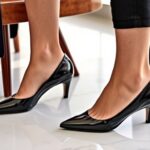You shouldn’t be required to wear heels at work; it’s an outdated expectation that disregards comfort and individuality. High heels can cause health issues like foot pain and posture problems, making it tough to focus on your job. Embracing inclusive dress codes allows you to express your style without compromising professionalism. Companies that prioritize comfort over rigid norms foster a happier, more productive workplace. Curious about how this shift is taking hold in modern workplaces?
Historical Context of Workplace Attire

When you think about workplace attire, it’s easy to overlook the rich history that shaped what we wear today. Feminine fashion, in particular, has evolved dramatically, influenced by societal norms and workplace expectations. In the past, women’s clothing was often restrictive, reflecting a world where their roles were limited. However, as women began to enter the workforce in larger numbers, a shift occurred.
You might notice that modern outfits blend professionalism with personal style, allowing for comfort and expression while still meeting workplace standards. This evolution isn’t just about aesthetics; it symbolizes empowerment and the breaking of traditional barriers. Today, the expectation to wear heels can feel like a throwback to outdated norms, pushing you to conform rather than express your individuality. As you navigate your wardrobe choices, consider how history has shaped these expectations and embrace the power of choosing what makes you feel confident and authentic.
The Impact of High Heels on Health
While high heels can add a touch of elegance to your outfit, they often come with significant health drawbacks that shouldn’t be ignored. Your foot health may suffer, leading to injury risks and long-term effects that can impact your daily life. High heels can cause posture issues and circulation problems, ultimately affecting your workplace safety.
| Health Concern | Impact | Alternative Footwear |
|---|---|---|
| Foot Pain | Discomfort and fatigue | Flats, sneakers |
| Posture Issues | Back pain and misalignment | Low-heeled shoes |
| Injury Risk | Sprains and fractures | Supportive sandals |
| Circulation Problems | Swelling and numbness | Loafers or slip-ons |
| Long-Term Effects | Bunions and arthritis | Comfortable boots |
Choosing alternative footwear can enhance your comfort levels, making work more enjoyable without compromising your style. Consider what’s best for your health!
Gender Norms and Professionalism

Although many workplaces still adhere to traditional gender norms, it’s crucial to recognize how these expectations can shape perceptions of professionalism. You might feel pressured to conform to gender expectations that dictate what you should wear—like heels—just to fit into the workplace culture. This can feel outdated and even discriminatory, reinforcing the idea that women must dress a certain way to be taken seriously.
When you challenge these norms, you’re not just advocating for personal comfort; you’re pushing for a more inclusive workplace where skills and performance matter more than appearance. Imagine a work environment where professionalism isn’t tied to footwear but instead to the quality of your contributions. Embracing diverse styles can lead to a richer, more dynamic culture, allowing everyone to express themselves authentically. It’s time to rethink what professionalism truly means and make sure it aligns with modern values of equality and respect.
Case Studies: Companies With Heel Policies
Let’s take a closer look at companies with specific heel policies and how they shape corporate dress codes. You might be surprised to find that these rules often spark conversations about gender discrimination, pushing the boundaries of what’s considered professional. It’s time to question whether these expectations truly empower women or just uphold outdated norms.
Corporate Dress Codes
When it comes to corporate dress codes, companies often set policies that reflect their values and culture, yet many still enforce specific rules around footwear, particularly heels. This can create a disconnect between a modern workplace uniform and outdated expectations. You deserve to feel comfortable while showcasing your professional style—why not adopt a business casual approach that prioritizes both? Companies like Google and Facebook have embraced more relaxed dress codes, allowing employees to express themselves without the constraints of heels. By shifting the focus from strict footwear policies to a broader interpretation of professionalism, organizations can foster a more inclusive and empowering environment. After all, smart style shouldn’t come at the cost of comfort or well-being!
Gender Discrimination Issues
Many companies maintain strict heel policies that not only dictate style but can also reinforce gender discrimination. These fashion expectations often create workplace inequality, pressuring women to conform to outdated norms. Here are some striking case studies:
- A major airline faced backlash after enforcing a heel policy for female flight attendants, sparking a debate on comfort vs. appearance.
- A tech firm was criticized for requiring women to wear heels during meetings, overshadowing their professional capabilities.
- A law office revealed a double standard, as male employees enjoyed relaxed shoe guidelines.
- A retail giant dropped its heel policy after public outcry, recognizing the need for inclusivity.
It’s time to challenge these outdated practices and promote a more equitable work environment.
The Shift Towards Inclusive Dress Codes

As workplaces evolve, the push for inclusive dress codes has gained momentum, making it clear that comfort and self-expression matter just as much as professionalism. You’re no longer confined to rigid attire that doesn’t reflect who you are. Inclusive attire embraces workplace diversity, recognizing that each individual brings unique perspectives and styles.
Imagine walking into a meeting wearing what makes you feel confident—be it sneakers, flats, or even creative accessories. This shift promotes a sense of belonging that encourages collaboration and innovation. Companies that adopt inclusive dress codes not only attract diverse talent but also foster an environment where everyone feels empowered to express themselves.
It’s time to rethink outdated norms and embrace the idea that professionalism can coexist with authenticity. By supporting inclusive dress codes, you’re contributing to a culture that values individuality and recognizes the strength in differences.
Empowering Choice in Professional Settings
In today’s workspace, your outfit should reflect who you are, not just what’s expected. When you prioritize comfort, you boost your productivity and confidence, making your personal expression shine. It’s time to embrace choices that empower you, whether that means heels or something more laid-back.
Personal Expression and Identity
While the debate around whether women should wear heels at work often centers on comfort and professionalism, it’s essential to recognize that footwear can also serve as a powerful form of personal expression. Your shoes can reflect your cultural identity and unique style, allowing you to showcase who you truly are in a professional environment.
- Heels can convey confidence and assertiveness.
- Sneakers or flats may highlight a more relaxed, creative vibe.
- Unique designs can celebrate cultural background and heritage.
- Footwear choices can empower self-expression beyond traditional norms.
When you get to choose what to wear, it’s not just about looking good; it’s about embracing your individuality and making a statement that resonates with your identity.
Comfort and Productivity Considerations
Footwear choices play an important role in how you navigate your workday, impacting both comfort and productivity. When you think about comfort vs. style, it’s essential to remember that what feels good on your feet can greatly affect your performance. If you’re constantly adjusting your heels or wincing in discomfort, your focus drifts, and productivity plummets. On the flip side, opting for stylish flats or supportive shoes can boost your confidence and keep you engaged. Empowering choice in professional settings means acknowledging that comfort shouldn’t sacrifice style. A well-considered footwear choice can enhance your workflow and elevate your overall work experience, proving that you don’t have to compromise comfort for professionalism. After all, happy feet lead to happy workdays!
Frequently Asked Questions
Are There Legal Implications for Enforcing Heel Policies at Work?
Imagine a garden where only certain flowers thrive; enforcing heel policies can lead to legal rights violations and workplace discrimination. Guarantee every bloom flourishes equally, or risk facing the legal thorns of inequity and injustice.
How Do High Heels Affect Women’s Confidence in the Workplace?
High heels can give you a confidence boost, enhancing your workplace image. When you feel empowered in your appearance, it radiates through your performance and interactions, making you more assertive and engaged in your professional environment.
What Alternatives to Heels Are Considered Professional Attire?
Picture stepping into the office with confidence, wearing stylish flats or chic loafers instead of heels. Professional shoe options like block heels or ankle boots offer both comfort and elegance, proving that flats versus heels can be equally sophisticated.
How Do Cultural Differences Influence Heel Requirements in Workplaces?
Cultural norms shape workplace expectations, influencing whether heels are seen as essential. In some cultures, they signify professionalism, while others embrace comfort. Understanding these differences can help you navigate your own workplace dress code effectively.
Can Men Be Required to Wear Heels in Any Context?
Heels for him? Hardly happening! Yet, heel policies often reflect outdated gender expectations. You’ve got to advocate for gender equality, pushing past traditional norms. It’s time to challenge stereotypes and embrace footwear freedom for everyone!



